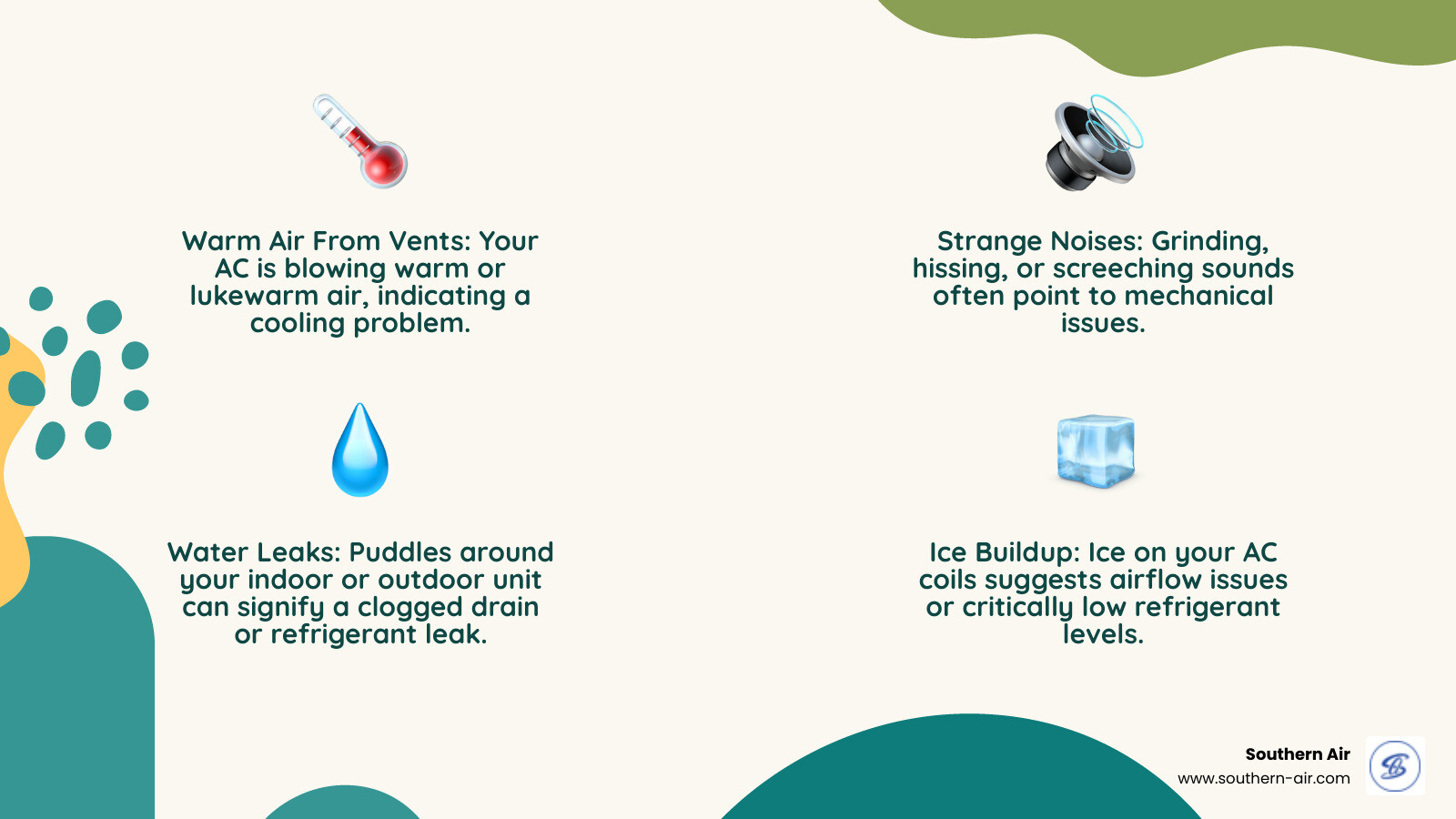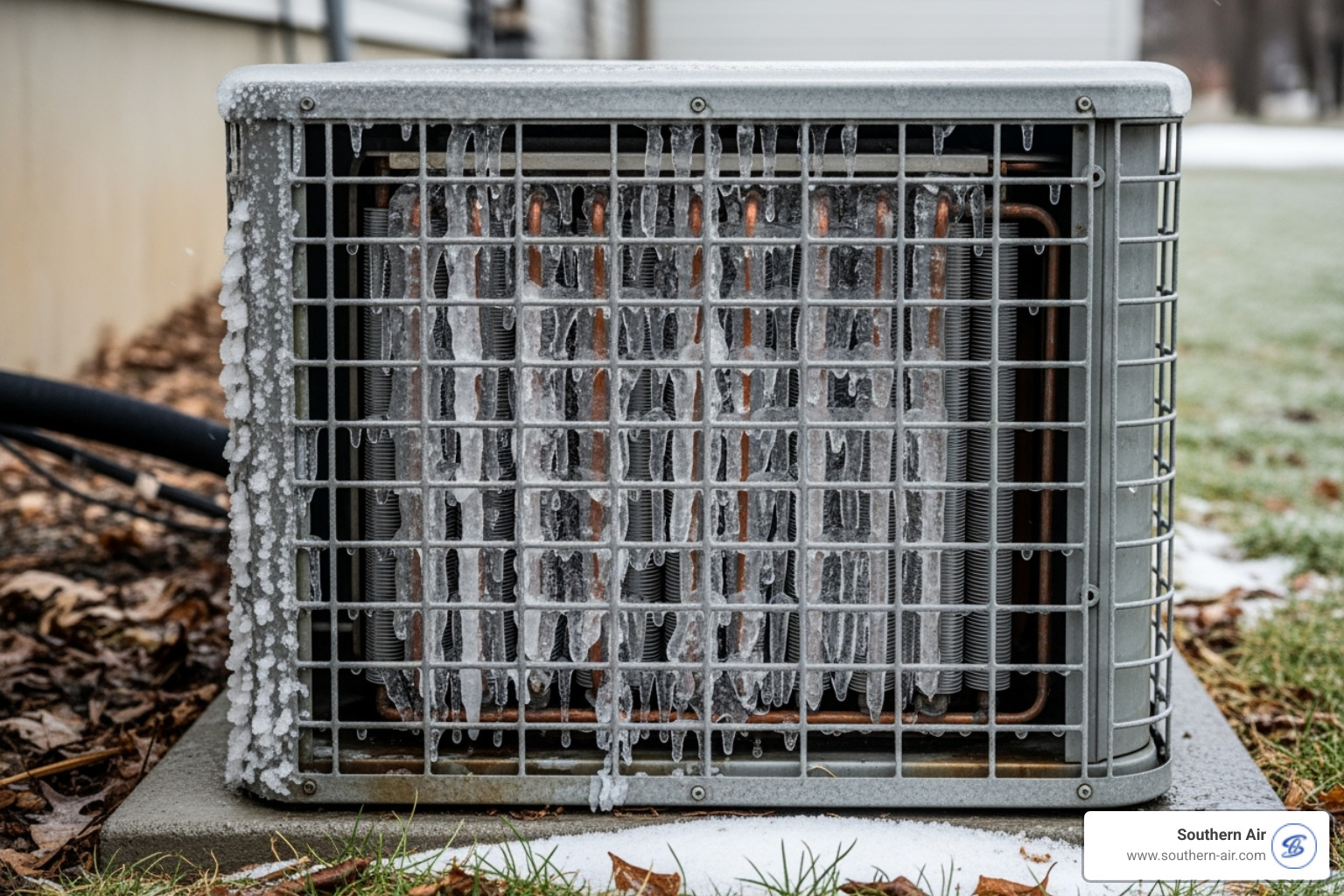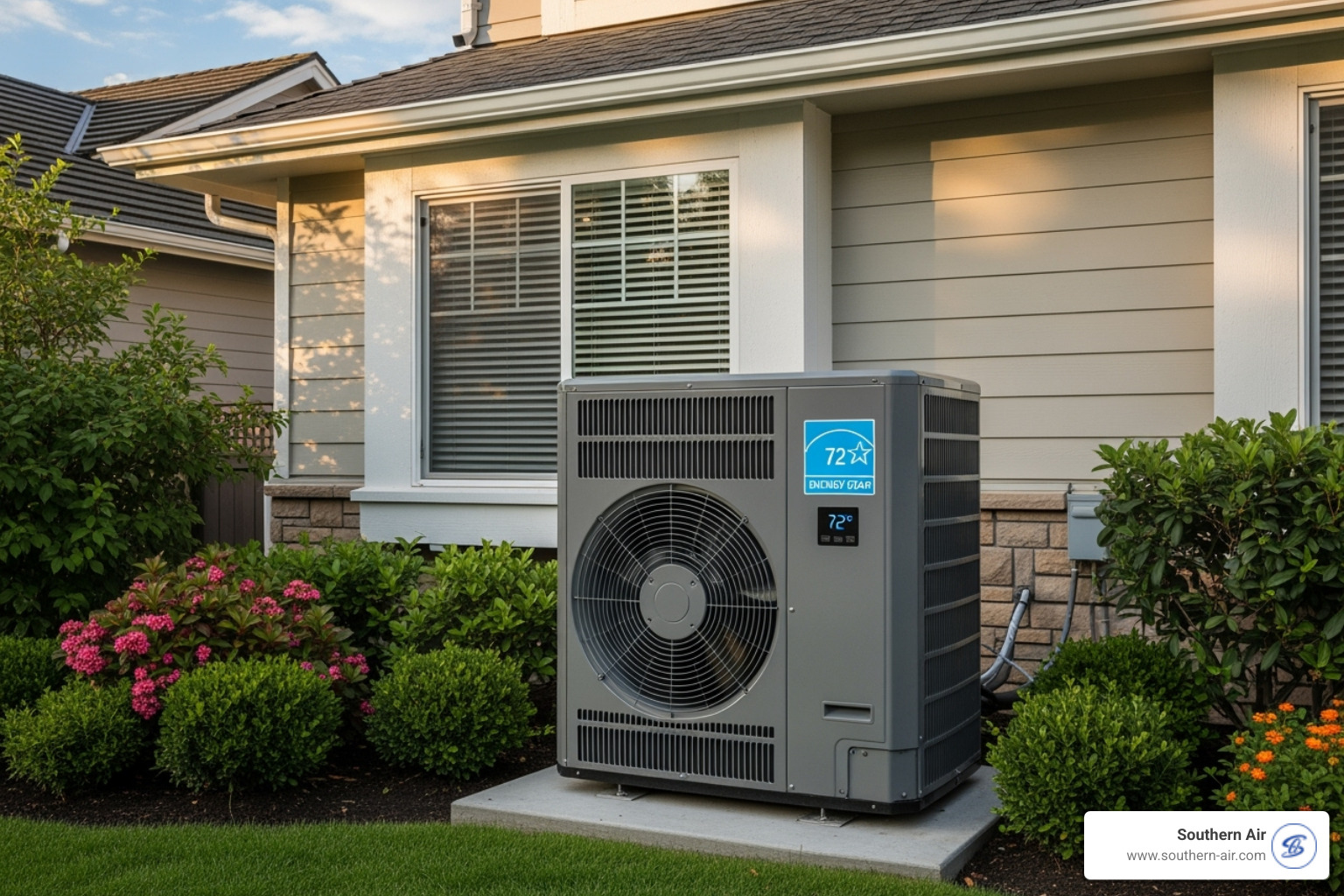When Your AC Breaks Down: Quick Solutions and Warning Signs
Broken AC repair becomes urgent when your air conditioner fails during hot weather. Here’s a quick guide to what you need to know.
Immediate Steps for Broken AC Repair:
- Check your thermostat - Ensure it's set to "cool" and below room temperature.
- Inspect the circuit breaker - Reset if tripped, but avoid resetting it repeatedly.
- Replace dirty air filter - Clogged filters are a common cause of AC failure.
- Clear outdoor unit - Remove debris blocking airflow around the condenser.
- Call a professional if these steps don't work or you notice burning smells or leaks.
When to Call Emergency Service:
- No cool air and indoor temperatures are rising
- Strange noises like grinding, screeching, or hissing
- Visible water leaks or ice buildup
- Burning or electrical odors
- Circuit breaker trips repeatedly
Most AC problems have predictable causes. Minor issues like clogged drain lines or failed capacitors might cost $100-$300, while major repairs involving compressors can exceed $1,000. Acting fast is key. Running a broken AC can damage expensive components, turning a simple fix into a costly replacement. Understanding the warning signs helps you decide when to troubleshoot and when to call a professional, especially since high-voltage electricity and refrigerant require expert handling for safety.

First Signs of Trouble: Is Your AC Broken?
When you walk into a hot house on a summer day, you get that sinking feeling that your air conditioner has failed. The good news is that your AC usually provides warning signs before it quits completely. Learning to spot these red flags can save you from a system meltdown and an emergency broken AC repair call.
Warm air blowing from your vents is the most obvious cry for help. If your thermostat is set to cool but the air isn't cold, something is wrong. This could point to a compressor issue, a refrigerant leak, or a thermostat problem.
Weak or no airflow is another sign not to ignore. This might be a simple dirty filter, but could also indicate leaky ductwork or a failing blower fan, leading to discomfort and higher energy bills.

Your AC shouldn't be noisy. Strange noises like grinding, screeching, or hissing are clear signs of trouble. Squealing can mean a bad fan motor bearing, hissing often signals a refrigerant leak, and grinding or clanging suggests loose or broken internal parts. Learn more in our guide on Common AC Noises That Signal Problems.
Foul or musty odors from your vents often indicate mold or mildew in the system, which impacts air quality. A burning smell is a serious red flag for electrical issues; turn off the AC immediately and call for help. Find solutions in our article on Solutions for Musty Home AC Odors.
Water leaks around your AC unit are never normal and usually point to a clogged drain line or frozen coils. Ignoring leaks can lead to water damage and mold. Read more in our guide Why is Your AC Unit Leaking Water?.
Short cycling, when the AC turns on and off too frequently, wastes energy and puts excessive strain on your system.
High humidity in your home when the AC is running suggests your system isn't dehumidifying properly, which could mean it's improperly sized or has an evaporator coil issue.
Finally, unexplained rising energy bills during cooling season often mean your unit is struggling due to dirty coils, low refrigerant, or other hidden problems.
Catching these issues early can turn a major repair into a minor one. For more details, see our guide on Signs Your AC Needs Professional Repair.
DIY Troubleshooting: What to Check Before You Call
When your AC acts up, you might be tempted to immediately call for broken AC repair. However, a few simple checks can sometimes save you time and money. Before calling a professional, try these DIY troubleshooting steps.
First, look at the most common culprit: the thermostat. Check your thermostat settings to ensure it's set to "cool" with a target temperature below the current room temperature. If it's battery-powered, try replacing the batteries, as low power can cause issues.

Next, head to your electrical panel. Inspect the circuit breaker for the AC unit. If it has tripped, flip it completely off and then back on. This can often resolve minor power interruptions.
Warning: If the breaker trips repeatedly, stop resetting it. This indicates a more serious electrical problem that requires a professional. Learn more about how to troubleshoot when your AC keeps turning off.
Now, check your air filter. Replace the air filter if it's dirty. A clogged filter restricts airflow, forcing your system to work harder and less efficiently. This simple step can solve many cooling problems and prevent future breakdowns. See our guide on how we perform air filter replacement for tips.
Head outside to inspect the outdoor unit. Clear the outdoor unit of any leaves, grass, or debris. It needs at least two feet of clearance on all sides to function correctly. You can gently rinse the coils with a garden hose, but avoid high pressure, as the fins are delicate.
Finally, check the condensate drain line for clogs. This line removes moisture from the air. A clog can cause water to back up, triggering a safety switch that shuts down the system. Look for water pooling near the indoor unit.
If these checks don't resolve the issue, it's time to call for professional help. Some problems are too complex or dangerous to fix on your own.
Understanding Common Causes and Costs of Broken AC Repair
When your AC breaks down, understanding the potential cause can help you communicate with your HVAC technician and prepare for the repair costs. Here are some of the most common issues we see.
Why Did My AC Stop Working? Common Culprits
- Refrigerant Leaks: Refrigerant carries heat out of your home. A leak prevents proper cooling, causing warm air from vents and ice buildup on coils.
- Electrical Failures: These can range from a tripped breaker to faulty wiring. A failed capacitor can prevent the motor from starting (you might hear a humming sound), while a worn contactor won't send power to the outdoor unit.
- Fan Motor Issues: A problem with the indoor blower or outdoor condenser fan will disrupt airflow, causing the system to overheat or fail.
- Dirty Coils: Grime on the evaporator or condenser coils acts like an insulating blanket, hindering heat exchange and forcing the system to work harder. Learn more about Proper AC Coil Maintenance at Home.
- Clogged Drain Line: This causes water to back up, which can trigger a safety switch that shuts down the system to prevent water damage.
- Compressor Failure: The compressor is the heart of your AC. Its failure is one of the most expensive repairs and will stop your unit from cooling entirely. Find out more about Why Your AC Compressor Won't Start.
- Thermostat Malfunction: A faulty thermostat can cause erratic behavior or make the system unresponsive.
How to Know if Your AC is Low on Refrigerant
Refrigerant is in a closed loop; it doesn't get "used up." Low levels mean there's a leak. Running an AC with low refrigerant can cause severe damage. Signs include:
- Hissing sounds near refrigerant lines.
- Ice on coils due to a pressure drop in the system.
- Ineffective cooling and longer run times as the system struggles.
The type of refrigerant also matters. Older R-22 refrigerant is phased out and expensive, making leak repairs on older systems costly. Newer systems use R-410A. The environmental impact of older refrigerants is significant.
Estimating Your Broken AC Repair Costs
Repair costs vary, but here's a general idea of what to expect for a broken AC repair.
- Diagnostic Fee: Most repairs start with a diagnostic fee to identify the problem.
- Minor Repairs ($100-$300): This range typically covers issues like cleaning drain lines or replacing a capacitor.
- Major Repairs ($1,000+): Critical components like compressors or evaporator coils are more complex and costly to repair or replace.
Costs are influenced by the unit's age and model, accessibility of the broken part, and whether it's an emergency service call. For transparent pricing in our service area, check out our AC Repair Lynchburg VA page.
Repair or Replace? Making the Right Financial Decision
Facing a significant broken AC repair bill leads to a tough question: is it better to fix the unit or replace it? Here are some factors to help you decide.
A helpful guideline is the $5,000 rule: multiply the unit's age by the estimated repair cost. If the result is over $5,000, replacement is likely the smarter financial choice. For example, a 12-year-old unit needing an $800 repair ($9,600) suggests replacement.
- Unit Age: Most AC systems last 12-15 years. Investing in major repairs for an older unit can lead to a cycle of recurring breakdowns as other parts begin to fail.

- Frequent Breakdowns: If repair calls are becoming a regular occurrence, the costs can add up quickly. At some point, you may be throwing good money after bad.
- Repair Cost vs. Replacement Cost: If a repair costs more than 50% of a new system's price, replacement is often the better long-term investment, especially for major jobs like a compressor replacement.
- System Efficiency: Modern AC units have much higher SEER ratings (14-20+) compared to older models (8-10). The monthly energy savings from a new, high-efficiency unit can help offset the initial cost.
- Phased-Out Refrigerants: Systems using R-22 (Freon) are costly to repair due to the refrigerant's scarcity and high price. A significant leak in an R-22 system often makes replacement the most practical option.
The decision isn't always easy. Sometimes a repair buys you time, while other times replacement is the clear choice. We can help you weigh the options for your specific situation. If you're seeing multiple red flags, our guide on Warning Signs AC Needs Professional Replacement can help. When you're ready to explore new systems, our AC Replacement Lynchburg VA team can guide you through the best options.
When to Call the Professionals: DIY Risks and Emergency Service
While simple DIY checks are encouraged, complex broken AC repair should be left to professionals due to significant risks. Understanding these dangers can help you make a safe choice.
The Dangers of DIY AC Repair
- Electrical Shock Risk: AC units use high-voltage electricity that can be fatal. Professionals have the training and safety equipment to handle it safely.
- Hazardous Refrigerant Handling: Refrigerant is a pressurized, hazardous material that requires certified handling. Improper release is illegal and harmful to the environment.
- Voiding Your Warranty: Most manufacturers' warranties are voided if repairs are not performed by a licensed professional.
- Causing More Damage: A misdiagnosis or incorrect repair can turn a minor issue into a major, expensive problem, potentially requiring a full system replacement.
- Lack of Specialized Tools: Proper diagnosis and repair require tools like refrigerant gauges and vacuum pumps that homeowners don't typically own.
What to Expect from an Emergency AC Repair Service
AC units often break down at the worst times. When an emergency strikes, you need a reliable repair service.
- 24/7 Availability: Our emergency service is available around the clock because we know emergencies don't stick to business hours.
- Rapid Response: We provide a rapid response, prioritizing calls where extreme heat poses a health risk to vulnerable individuals like children or the elderly, as noted by the EPA's research on the health risks of extreme heat.
- Certified Technicians & Stocked Vehicles: Our NATE-certified technicians arrive in stocked service vehicles, allowing them to diagnose and fix most problems in a single visit.
- Upfront Pricing: We provide clear, upfront pricing before any work begins, so there are no surprises.
When your AC fails unexpectedly, you can rely on our team for prompt, professional service. For immediate assistance, contact our HVAC Emergency Repair Lynchburg VA team.
Frequently Asked Questions about Broken AC Repair
Here are answers to some of the most common questions we receive about broken AC repair.
How can I prevent costly AC repairs in the future?
Regular professional maintenance is the best prevention. Annual tune-ups are like an insurance policy against major breakdowns. During a visit, technicians inspect the system, clean coils, check refrigerant, and test components to catch small issues before they become expensive problems. This also helps keep your manufacturer's warranty valid. Find more advice in our guide on Preventing HVAC Breakdowns: Tips.
How long does a typical AC repair take?
The time depends on the issue. Minor repairs, like replacing a capacitor or cleaning a drain line, often take less than two hours, as our trucks are stocked with common parts. Major repairs, such as replacing a compressor or coil, can take several hours and may require ordering parts, necessitating a return visit. We always communicate the timeline clearly.
Is it okay to run my AC if it's not cooling properly?
No, turn it off immediately. Running a malfunctioning AC can cause catastrophic damage to key components, like the compressor. What might be a simple fix can quickly become a costly system replacement. If you notice warm air, strange noises, or ice buildup, shut the system down and call a professional. This simple step can save you a significant amount of money and frustration.
Conclusion
Dealing with a broken AC repair can be stressful, but you now have the knowledge to handle it. By recognizing warning signs and performing simple troubleshooting, you can often prevent major issues.
However, it's crucial to know when to call a professional. Electrical work and refrigerant handling are dangerous and require expert knowledge for safety. Attempting complex DIY repairs can lead to more damage and void your warranty.
Safety always comes first. The best strategy is proactive maintenance and prompt professional help when needed. Since 1946, Southern Air has provided reliable service to Lynchburg families, saving them stress and money. Your comfort and safety are our priorities.
Don't let a broken AC disrupt your life. Contact us today for 24-hour AC repair in Lynchburg, VA!
